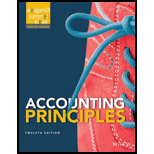
Concept explainers
(a)
Journalizing: It is the process of recording the transactions of an organization in a chronological order. Based on these
Accounting rules for journal entries:
- To increase balance of the account: Debit assets, expenses, losses and credit all liabilities, capital, revenue and gains.
- To decrease balance of the account: Credit assets, expenses, losses and debit all liabilities, capital, revenue and gains.
To prepare: Journal entries.
(b)
T-Account: T-Account is a form of ledger account in which the debit entries are shown at the left side of the account and credit entries are shown at the right side of the account.
To prepare: T-Accounts
(c)
To prepare: A trial balance.
Want to see the full answer?
Check out a sample textbook solution
Chapter 2 Solutions
Accounting Principles - Standalone book
- Please provide the accurate answer to this accounting problem using appropriate methods.arrow_forwardI need assistance with this general accounting question using appropriate principles.arrow_forwardCost of Production Report The debits to Work in Process-Roasting Department for Morning Brew Coffee Company for August, together with Information concerning production, are as follows: Work in process, August 1, 700 pounds, 10% completed *Direct materials (700 x $2.60) Conversion (700 x 10% x $1.00) Coffee beans added during August, 22,000 pounds Conversion costs during August Work in process, August 31, 1,100 pounds, 40% completed Goods finished during August, 21,600 pounds < All direct materials are placed in process at the beginning of production. $1,890* $1,820 70 $1,890 56,100 24,167 ? ? a. Prepare a cost of production report, presenting the following computations: 1. Direct materials and conversion equivalent units of production for August 2. Direct materials and conversion costs per equivalent unit for August 3. Cost of goods finished during August 4. Cost of work in process at August 31 If an amount is zero, enter in "0". For the cost per equivalent unit, round your answer to…arrow_forward
- Please provide the answer to this financial accounting question using the right approach.arrow_forwardPlease help me solve this financial accounting problem with the correct financial process.arrow_forwardV The debits to Work In Process-Roasting Department for Morning Brew Coffee Company for August, together with Information concerning production, are as follows: Work in process, August 1, 700 pounds, 10% completed *Direct materials (700 x $2.60) Conversion (700 x 10% x $1.00) Coffee beans added during August, 22,000 pounds Conversion costs during August Work in process, August 31, 1,100 pounds, 40% completed Goods finished during August, 21,600 pounds All direct materials are placed in process at the beginning of production. a. Prepare a cost of production report, presenting the following computations: 1. Direct materials and conversion equivalent units of production for August 2. Direct materials and conversion costs per equivalent unit for August 3. Cost of goods finished during August 4. Cost of work in process at August 31 $1,890* $1,820 70 $1,890 56,100 24,167 ? ? If an amount is zero, enter in "0". For the cost per equivalent unit, round your answer to the near st cent. Morning…arrow_forward
- Can you help me solve this general accounting problem with the correct methodology?arrow_forwardPlease help me solve this financial accounting problem with the correct financial process.arrow_forwardI need help finding the accurate solution to this general accounting problem with valid methods.arrow_forward

 AccountingAccountingISBN:9781337272094Author:WARREN, Carl S., Reeve, James M., Duchac, Jonathan E.Publisher:Cengage Learning,
AccountingAccountingISBN:9781337272094Author:WARREN, Carl S., Reeve, James M., Duchac, Jonathan E.Publisher:Cengage Learning, Accounting Information SystemsAccountingISBN:9781337619202Author:Hall, James A.Publisher:Cengage Learning,
Accounting Information SystemsAccountingISBN:9781337619202Author:Hall, James A.Publisher:Cengage Learning, Horngren's Cost Accounting: A Managerial Emphasis...AccountingISBN:9780134475585Author:Srikant M. Datar, Madhav V. RajanPublisher:PEARSON
Horngren's Cost Accounting: A Managerial Emphasis...AccountingISBN:9780134475585Author:Srikant M. Datar, Madhav V. RajanPublisher:PEARSON Intermediate AccountingAccountingISBN:9781259722660Author:J. David Spiceland, Mark W. Nelson, Wayne M ThomasPublisher:McGraw-Hill Education
Intermediate AccountingAccountingISBN:9781259722660Author:J. David Spiceland, Mark W. Nelson, Wayne M ThomasPublisher:McGraw-Hill Education Financial and Managerial AccountingAccountingISBN:9781259726705Author:John J Wild, Ken W. Shaw, Barbara Chiappetta Fundamental Accounting PrinciplesPublisher:McGraw-Hill Education
Financial and Managerial AccountingAccountingISBN:9781259726705Author:John J Wild, Ken W. Shaw, Barbara Chiappetta Fundamental Accounting PrinciplesPublisher:McGraw-Hill Education





